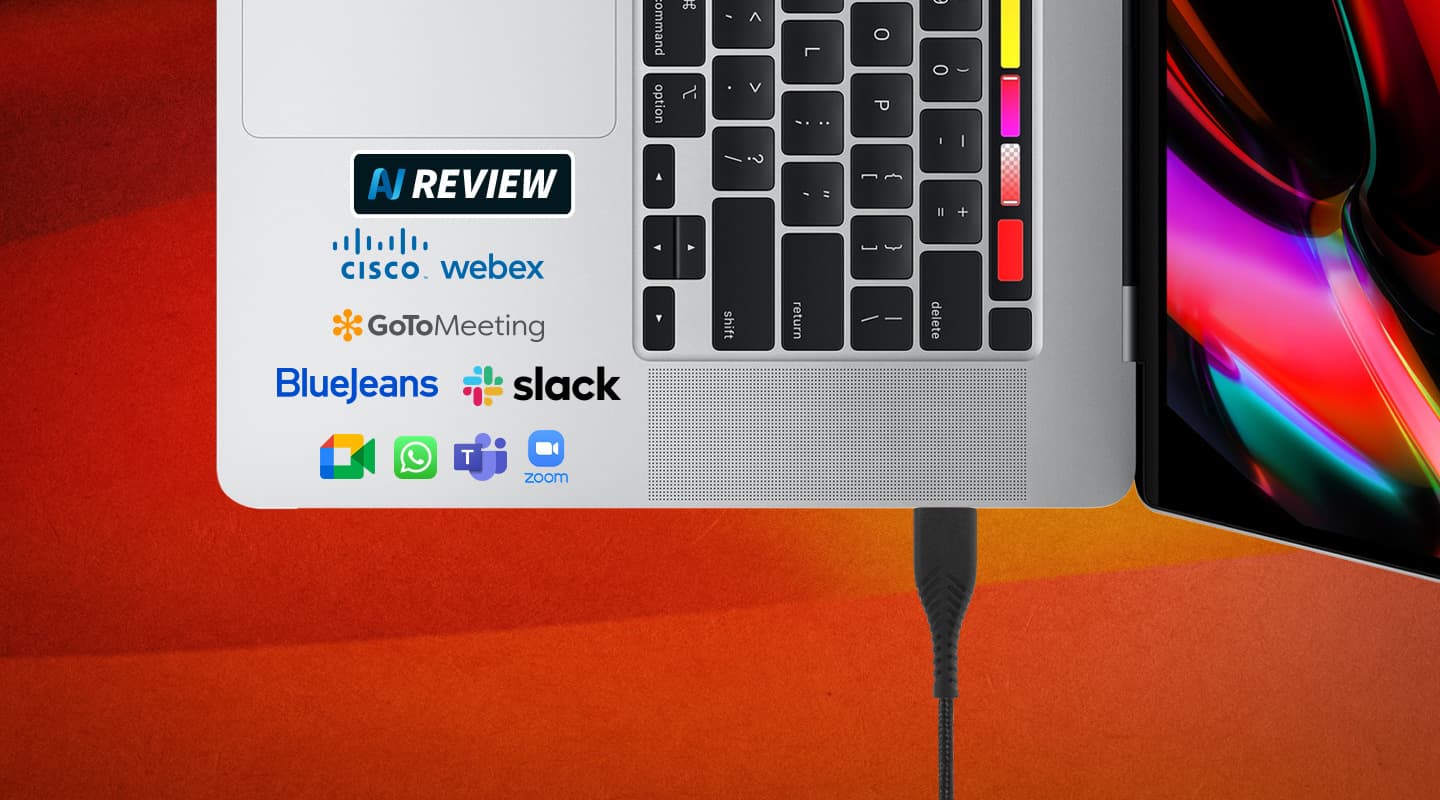
Bring Your Own Meeting (BYOM)
A market comparison by technology specialists.
Review:/ Grant Bates, Pereira Projects
While platform specific, room-based systems — such as those offered by Microsoft and Zoom — have changed the way meeting spaces are designed and used, commitment to a single platform is often an issue for organisations, staff, and particularly their guests. Standardisation on a UC platform has many benefits but still people want to have the option to use a device and platform that is familiar to them.
Some examples where we see a need for UC choice are where:
- An organisation hasn’t standardised to one platform
- Different departments within an organisation have standardised on different platforms
- A guest wants to host a meeting but uses a different platform from the organisation’s standard
- Spaces are periodically used by external tenants
- A meeting is already running on a user’s device when they enter the space and they want to transfer it to the room
- Users wish to avoid touching in-room equipment and prefer to run from their own device
BYOM solutions allow users to “take advantage of the enterprise-grade cameras and microphones in the room from any personal device on any platform”. Rather than elaborate on the definitions and benefits of BYOM — Mersive do a fantastic job of that here — this article gives an overview of ten leading solutions, and looks at what functionality distinguishes them from one another.
Some key questions are:
- Does the solution provide BYOM only? Or can it work alongside a room-based system?
- Is the solution peripheral agnostic? Or does it only work with its manufacturer’s cameras and mics?
- What is the laptop connection? HDMI? USB-C? Dual cable? Single cable? Wireless?
- Are other supporting technologies provided to the user’s device? Charging? Wired LAN access?
- Is software or driver installation required on the user device?
- Does it work for single and/or dual screen systems?
LOGITECH SWYTCH


Logitech has designed a cool solution to the ‘BYOM plus room-based system’ problem. Providing users with the choice of USB-A or USB-C connections from its proprietary flylead, the Swytch relies on DisplayLink Plug-and-Display to combine USB data with HDMI video on a single cable rather than the dual cable solutions their Rally and Tap products offer.
Behind the scenes is a Swytch Hub connected to the room-based NUC and outputting HDMI to the display; as well as a Swytch Extender below the table to handle input and extension from the Swytch cable. Note that an included 5m Logitech Strong USB cable connects the Hub and Extender boxes, but 10m and 25m versions can also be purchased to cover longer distances.
Limited to a single USB connection for room peripherals, the Swytch is clearly best paired with an all-in-one conferencing bar such as the Logitech Meetup or Rally Bar. For larger systems Rally Plus kits with PTZ cameras, mic pods and speakers are available to connect via a Room Hub. Some bench testing is advised, but the Swytch should also support multiple peripherals connected via any suitable USB 3.1 hub as long as USB tier limits are not exceeded. The USB-C connector is supplied with 60W of USB power for charging but no wired LAN is passed to user devices.
Logitech have paid attention to installation details such as flylead reticulation with a magnetic grommet for tidy strain relieving cable management. This also helps to distinguish the Swytch connection from cables intended as content inputs for the room-based system.
Logitech: logitech.com
CRESTRON UC-CX100
The hugely successful Crestron UC kits come as either a Teams or Zoom bundle, but the CX range adds BYOM to that bundled room-based system. In practice what this means is that a UC presentation transmitter (UC-PR) extends a host laptop connection via Cat5 cabling, to a video and USB switching hub (HD-CONV-USB-260), auto-switching the room’s peripherals from the room-based system to the BYOM device.
Note neither the UC-PR nor the HD-CONV-USB-260 is available for individual purchase.
BYOM connection can be either USB-C (Teams only) or HDMI and USB-A, or both (with priority set to USB-C in the absence of any manual switching). The USB-C port uses Displayport Alternate Mode and provides 60W of USB power to compatible devices. The Crestron UC-CX kits come with both a conferencing NUC and a touch panel which streamlines design and deployment. Though this is important to note in situations where client supplied and managed computers, or alternative touch panels are preferred.
Installation speed is also considered with the pictured ready-to-go bracket assembly (UC-BRKT-150-Z-ASSY).
Crestron: crestron.com

BIAMP USB 200 & DEVIO SCR-10

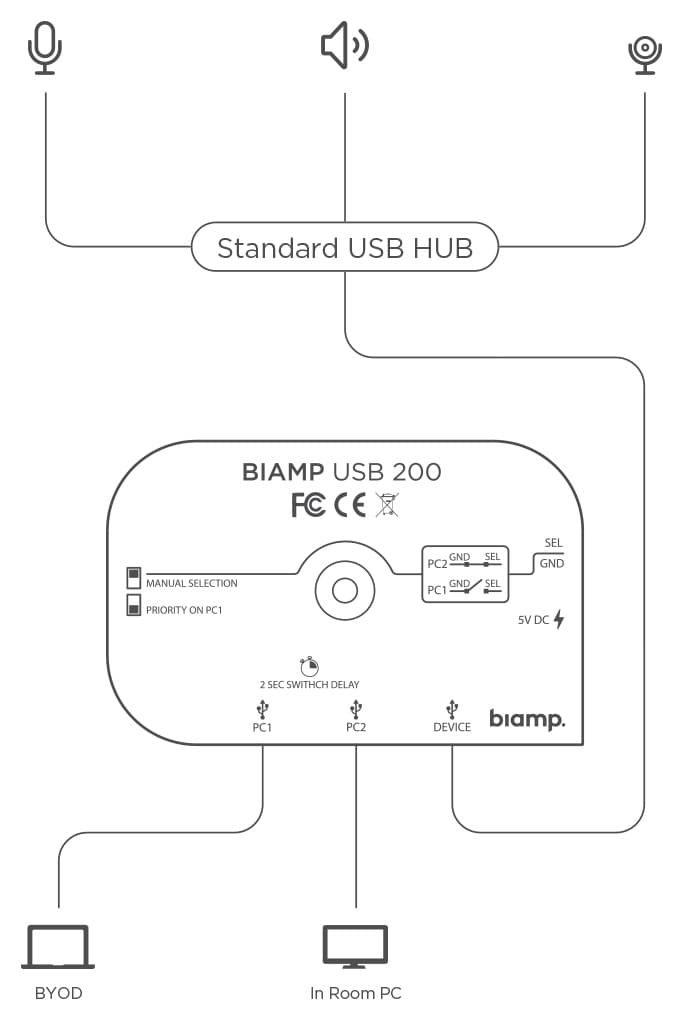
Formerly the Neets Solvo, Biamp’s Devio SCR-10 is an affordable BYOM hub aimed at providing a single USB-A connection to users for access to room peripherals and presentation via its HDMI output. Ample brand agnostic connectivity is provided with 3x USB and 2x AUX ports for peripheral devices, which means that mixing and matching cameras and audio solutions isn’t an issue. For more complex rooms the Devio SCR-20 and SCR-25 offer more I/O and onboard DSP on top of all the functionality of the SCR-10.
In BYOM only designs, CEC and wake-on-signal technology turns the display and the connected peripheral devices on/off based on signal detection from a user’s device. However, designs combining the SCR-10 with Biamp’s nifty USB-200 can provide intelligent USB switching between a room-based system and BYOM hub. The USB-200 implements a 2 second power switch delay when switching between connections to ensure USB stability. The device can be configured for automatic priority switching or set up for manual control from a third party system via an IO connection.
The SCR-10 uses DisplayLink Plug-and-Display technology and while it can provide LAN access over USB, no USB power is provided for charging user devices. If backward compatibility is a consideration, use of the ubiquitous USB-A connection is possible. This will work with USB 2.0 devices, albeit at reduced resolutions.
Biamp: biamp.com
Australian Distributor: jands.com.au
LIGHTWARE TAURUS UCX


Lightware’s range of integrated USB and HDMI switchers provide unrivalled flexibility with up to 4x host devices, 4x USB peripherals and 2x HDMI outputs. Host connections can either be USB-C, or USB-A and HDMI depending on the model variant, with USB-C providing charging up to 60W and LAN access.
A Taurus-based room could switch USB cameras and audio between multiple host connections such as a Teams Room NUC, a Zoom Room NUC, a house PC and a BYOM connection. With Dante and analog audio outputs, built-in control processing, and even an occupancy sensor input, there isn’t really anything else on the market that can provide this level of connectivity when handling complex meeting spaces from one device.
Yet another feature that sets the Taurus apart is the ability to display 4K 60Hz content with 4:4:4 colour. This is achieved utilising Displayport Alternate Mode rather than DisplayLink Plug-and-Display. As such, USB-3.1 active cabling or extension at 5Gb/s becomes a key consideration when designing systems with for the Taurus UCX.
Despite all this functionality, Lightware has kept the form factor relatively compact. And while some of the plug-and-play simplicity seen in other solutions is traded for extended features, the configuration and set up appears to be pretty straightforward.
Lightware: lightware.com
BARCO CLICKSHARE CONFERENCE

The CX-20, CX-30, and CX-50 make up Barco’s range of wireless BYOM solutions. For users with the Clickshare app installed on their device, connection to the room’s display and UC peripherals is completely wireless. Otherwise, the familiar Clickshare button is available for quick and simple, software free connection.
The entire range provides the same BYOM functionality, with the CX-50 offering 1x USB-C and 3x USB-A connections for peripherals, compared to just 1x USB-C and 1x USB-A on the CX-20 and CX-30. BYOD features are added to successive variants with the CX-30 and CX-50 allowing two sources onscreen simultaneously as well as interactive touch screen compatibility. The CX-50 also provides a wired HDMI input.
While the USB-C Clickshare buttons — complete with USB-A adapters to improve compatibility — allow users to present and connect to the room’s devices without an app or wifi access, users with the app installed on their device will have a richer (and buttonless) experience. This includes the use of ‘PresentSense’ ultrasonic technology to allow Clickshare connection as soon as a user running the app enters the room.
Maximum resolution is 4K UHD at 30Hz from the HDMI output to the in-room display. The Clickshare app can also be used to retrieve a local view of the room’s display on a user device, display digital signage, and integrate with Outlook calendars. The Barco website provides a helpful tool to check if a USB peripheral is certified, compatible, or community tested. The certified list includes many major USB conferencing players and the compatible list provides considerably more.
Barco: barco.com
MERSIVE SOLSTICE CONFERENCE


Mersive’s Solstice Pod now provides Solstice Conference BYOM functionality on top of its feature rich BYOD solution. For Conference functionality the Solstice App and bundled drivers will need to be installed with admin privileges on the user’s device. Once this is done (or deployed via MSI or SCCM) Solstice Conference offers a super flexible collaboration and conferencing tool.
Multiple simultaneous connections (4, or unlimited depending on the license purchased) enable multi-source content sharing and markup on the one display, as well as sharing of that display into a video conference meeting. The Solstice App also supports some pretty cool calendar integration to launch meetings from a user device.
Mersive offers a subscription for continual updates and support after the first year and it is good to see that it now offers 3 year and 5 year subscription options to be bundled at time of purchase.
While there is a USB-C port on the Solstice device, this is only provided for sync functionality eg. rather than entering the access pin. A full featured BYOM USB-C connection would add a lot of appeal to this solution, especially if it could also be used to connect a room based NUC. Instead, with the v5.5 software release, Solstice allows integration with a supported USB switcher to provide wireless BYOM alongside a room based solution.
Single screen HDMI output resolution is 4K UHD but dual HDMI output systems are limited to 1080p, as is expected of wired HDMI inputs. Multiple USB connections and an auxiliary audio output allow the Solstice to support a range of integrated solutions.
Mersive: mersive.com
BIAMP MODENA


Biamp’s Modena is a wireless BYOM and presentation with connection through either the Modena app or a web browser. While both app and browser options allow BYOM functionality, a USB driver package will need to be installed if connecting via a web browser.
The Modena range consists of the Modena Hub, Modena Hub+, and Modena Server. The Hub and Hub+ offer the same core features and I/O, but the Hub+ has a built in wireless access point for direct connection to the device. This built in WAP — in addition to the standard LAN port — allow configuration of separate guest and enterprise network connections.
The Modena Server is slightly different. Rethinking the conventional meeting space architecture, Modena Server can host up to 7 virtual meeting spaces that can be accessed anywhere on the network. As such, a traditional in-room display within a dedicated space is no longer required. However, to incorporate a display one can either connect a suitable computer device running the Modena app via HDMI, or use a smart display that natively runs the Modena Android App. These displays would be treated as a participant able to join any collaboration session within a virtual meeting.
Keeping things simple, the Modena Hubs don’t offer a wired HDMI input, and with a single USB port they rely on the use of an all-in-one conferencing bar, a USB hub, or a device such as the SCR-20. A nice feature is that any devices connected to the hub can receive content being presented directly to their own screens. We can see this ‘Device-to-Device’ feature being particularly useful in auditorium or learning studio scenarios.
Biamp: biamp.com
Australian Distributor: jands.com.au
KRAMER VIA VERSA


VIA Versa is a feature that allows users to wirelessly connect to USB cameras and audio for BYOM conferencing on the Kramer VIA Connect², VIA Connect PLUS, VIA Campus², and VIA Campus² PLUS.
Up to four participants can share their screens simultaneously on the main display either using the VIA app mirroring feature, iOS mirroring via AirPlay, Windows and Android mirroring via Miracast, or ChromeBook mirroring. For BYOM conferencing however, users are required to install a VIA Versa driver.
The VIA range offers seven different models — each with slight variations in video resolution, maximum participants, I/O, and network interfaces — but on the whole the VIA Versa compatible models provide two or more USB connections so an external USB hub is unlikely to be required. If small form factor is a requirement, the VIA range leads the pack with its VIA Connect measuring only 74x74x34mm
At the higher end of the range, solutions such as the VIA Campus² PLUS provide an extensive list of features such as 4K60 video, live streaming, calendar integration, an internal web browser and YouTube player, file sharing, and digital signage integration. One critique would be the prominent power button on the front of the chassis which in some common mounting positions could be all too easily accessed or bumped.
Kramer: kramerav.com
CRESTRON AIRMEDIA



Crestron’s AirMedia range now offers wireless conferencing functionality through the AM-3100-WF, AM-3200, and AM-3200-WF. For BYOM (unless the Crestron AirMedia app and conferencing drivers are already installed, or packaged as part of your SoE) users will need to connect to wifi and install software for wireless access to conferencing peripherals.
Additional functionality and I/O provided on the 3200 model includes a wired HDMI input, COM and IR connections, analog audio output, and dual LAN connectivity for segregated internal and guest networks. Wired and wireless presentation sources are input at 1080p at 60Hz and then scaled to 4K at 60Hz via the HDMI output. This allows for the simultaneous display of up to 4x 1080p presentation sources.
Important to note is that only specific peripherals are supported for wireless conferencing. At the time of writing, these include Cisco Webex kit Mini, Crestron UC-SB1, Jabra Panacast, and Logitech’s Meetup, Brio, and Rally range. It is understood that a list of ‘community tested’ peripherals that are not officially supported by Crestron for use with AirMedia will be made available.
The potential to combine this wireless BYOM functionality with other Crestron wired, room-based conferencing solutions is promising — something we’d love to bench test when we can get our hands on the equipment.
Crestron: crestron.com
QSC Q-SYS CORE & I/O-USB BRIDGE






QSC’s BYOM solution utilises USB connections on its Core DSPs (Core 110f, Core Nano, Core 8 Flex) and I/O-USB Bridge device to deliver multiple channels of audio and networked Q-SYS cameras to user devices for conferencing. Scalability is a real point of difference for QSC, with the ability to add — and switch between — as many camera endpoints or computer hosts as required. Built around a DSP, audio solutions can be designed to accommodate complex spaces with advanced processing and EQ, multiple microphones, speaker zones, recording and hearing augmentation outputs, GPIO, and networked audio devices.
Unlike other solutions presented here, Q-SYS USB connections do not display video from the user device. Instead, a separate HDMI — such as that on the NV-32 — or wireless video connection would be required to present a user device to the in-room display. The upside of this is that no driver installation or DisplayPort Alternate Mode compatibility is required.
Whilst BYOM video functionality is limited to the QSC range of cameras, there is now a variety of options with field-of-view and zoom specs to suit different room requirements. PoE capability, and installation via a single network cable neatly removes the need for signal extension or conversion that other more affordable cameras might require.
Q-SYS also enables room controls to be integrated with room-based conferencing system interfaces for seamless and synchronised switching between room modes, camera controls and host devices. With their unrivalled scalability and flexibility Q-SYS’ BYOM solutions may stretch the budget of some projects — especially when compared to simpler small-room designs — but in more complex systems (and those already requiring a DSP) they usually provide the most value.
QSC: qsc.com
Australian Distributor: tag.com.au
CONCLUSION
When designing for BYOM there are two clear, primary considerations that need to be made; whether a room-based system is required alongside BYOM, and what connection type is most suited to the situation. The table below provides a helpful reference when addressing these initial questions.
While there are products and combined solutions that can offer it all, they usually come with an increased price tag. As such, a special mention needs to go to Biamp’s economical USB-200. For a small cost, this product grants the utility of combining room-based systems with either wired or wireless BYOM products.

Forgive the grey area in regard to the combination of wireless BYOM and switchable room-based systems. Technically there are many ways to do this but only the Lightware and QSC products can really achieve this (while offering suitable configurability to best integrate all three functions) without compromising the wired BYOM. Having said that, the enhanced experience of Mersive’s wireless BYOM running alongside a room-based system should see similar integrations from other wireless solutions following close behind.
From the Editor: Thanks to Grant Bates and Pereira Projects for their work on this comparison test. NB: AV.technology didn’t commission this review, it is simply republishing the findings with permission from Pereira Projects. If you’d like to talk more about the many and varied options for ‘bringing your own meeting’ then head to the Pereira Projects site, give Grant a yell or phone the office (02) 9089 8622

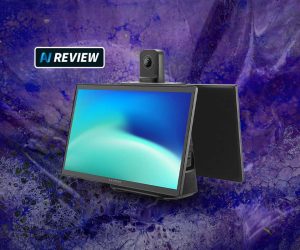
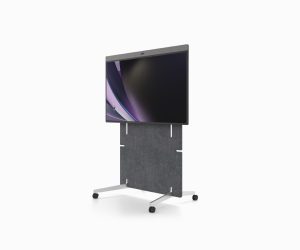
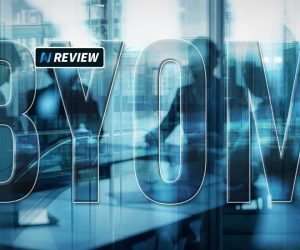
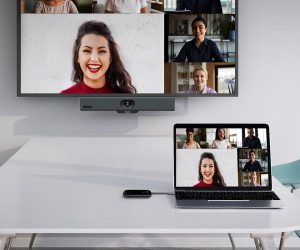

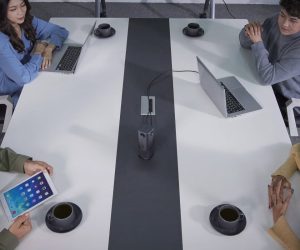
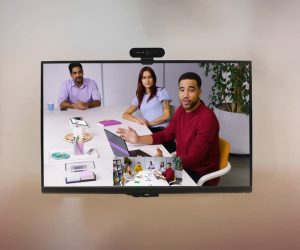
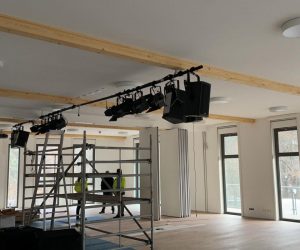
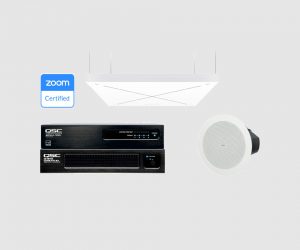
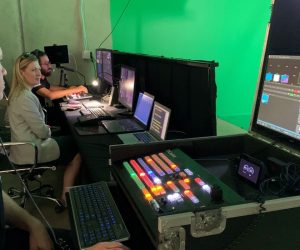
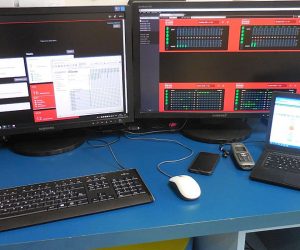



RESPONSES